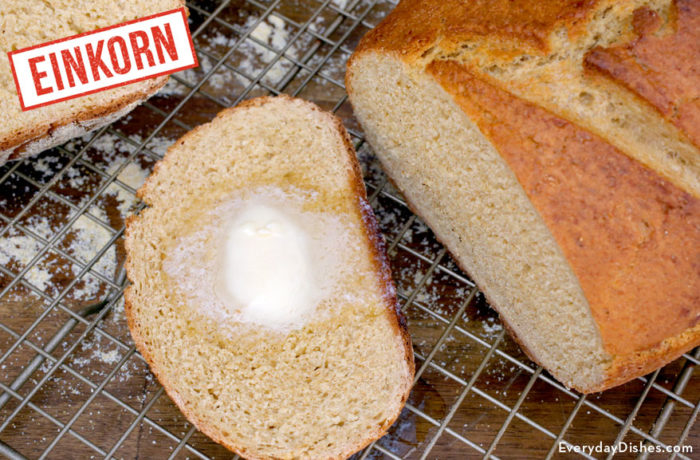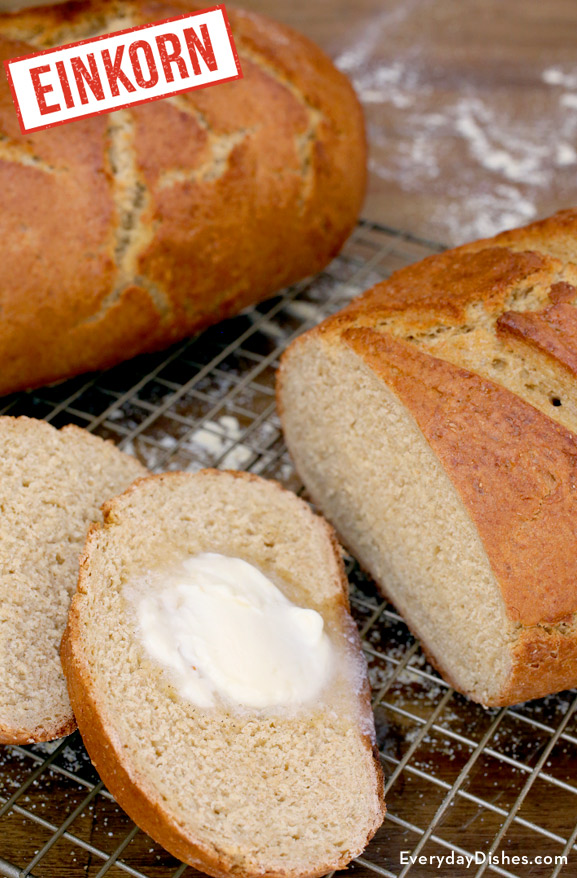Einkorn Whole Wheat Dutch Oven Bread Video

What is einkorn flour?
Watch our video and find out.
If you don’t already own a Dutch oven, now is the time to add it to your kitchen arsenal. Our homemade whole wheat Dutch oven bread is made with einkorn, so it’s easily (and happily) consumed, even if you’re sensitive to wheat! No einkorn wheat? No worries!
This post may include links to purchase items from our affiliates.
You can make multigrain bread using traditional all-purpose flour. You can find Dutch ovens online for $30 or less and they can be used in so many different ways. The cast iron is important in this recipe because it helps to capture the moisture evaporated during the cooking process. In turn, the bread will achieve a crispy, artisan crust!
It’s easier to make the starter a day before then let it sit over night. Or, if you start in the morning, you can have fresh bread come dinner! Once you try this recipe you’ll want to keep fresh bread in the house all the time! Cheryl likes to take a day to make several loaves so she always has yummy einkorn bread in the freezer!
Einkorn is helpful for those with gluten sensitivities or intolerances and not intended for those with celiac disease.

Einkorn Whole Wheat Dutch Oven Bread Recipe
Ingredients
sponge
- 1 1/4 tsp active dry yeast
- 1 1/2 cups water, 12 oz, 75–80 degrees (room temperature)
- 1 cup all-purpose einkorn flour, 4.5 oz
bread
- 1 tsp active dry yeast
- 1 Tbsp sugar
- 2 2/3 cups all-purpose einkorn flour, 12 oz
- 1 1/3 cups whole wheat einkorn flour, 6 oz
- 2 tsp salt
- cornmeal, for dusting
Instructions
sponge
- The sponge is simply a bit of the dough ingredients that are allowed to ferment for a period of time before the final dough is made. Why bother? The extra fermentation time adds a more complex flavor and we are all about flavor! Secondly, the fermentation allows the structure of the dough to relax and grow bigger. The result is lighter and tastier bread.
- In a small bowl, combine the yeast and water and whisk well to thoroughly dissolve the yeast. Add the flour and stir to form a thin batter.
- Cover the bowl with plastic wrap and let sit for an hour at room temperature.
- Place in the refrigerator for at least 8–12 hours but no longer than 24 hours before making the bread.
bread
- Remove the sponge and let it warm to room temperature. Add the remaining yeast and sugar and let it sit until the sponge starts to bubble, approximately 5–7 minutes.
- In a large bowl, add the salt to the flours and whisk to fully combine. Add the sponge to the flour mixture. Adding salt directly to the sponge will kill the yeast. Stir until the dough begins to come together. NOTE: We strongly recommend you weigh your einkorn flour, if possible, for better accuracy. If you don’t have a scale, fluff the flour with a fork before you measure it in a cup.
- Flour your hands and knead the dough until you have a smooth texture (only about 2 minutes). Einkorn doesn’t have the same gluten ratio as modern wheat and tends not to fight back so very little kneading is necessary. Let the dough rest for 10 minutes.
- Form the dough into the desired shape (ball or oval) and transfer to a cookie sheet coated with cornmeal. Cover with a large glass bowl then a towel to keep the light out and allow the dough to rise for approximately 40 minutes. Check early to make sure it is not over-proofing. The warmer your kitchen, the more quickly it will proof.
- When you start to see bubbles forming on the loaf, it is ready. Better to under-proof than over-proof.
- While the dough is proofing, preheat the oven to 425 degrees. Place a large Dutch oven and its lid in the oven to preheat.
- When ready to bake, using a very sharp knife or razor blade, make three slashes in the bread to allow for expansion during baking.
- Remove the Dutch oven from the oven, and slide the bread into it. Return the Dutch oven to the hot oven (lid on) and bake for 20 minutes then remove the lid and bake 13–15 minutes more. The bread will sound hollow when tapped and be at an internal temperature of 200 degrees.
- Invert the bread onto a rack to cool.
Notes


Hi. Can this recipe be doubled and then divided into two loafs before baking?
Absolutely! Let us know how it turns out.
Hello,
Is it possible to make this with a sourdough levain as opposed to the sponge recipe you have here? Thank you. I look forward to your reply.